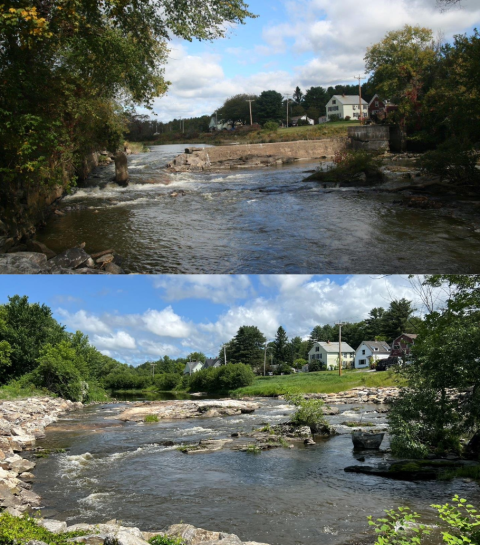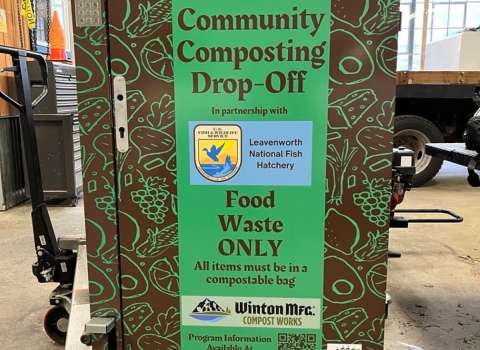You may have seen the headlines- Bipartisan Infrastructure Law Bipartisan Infrastructure Law
The Bipartisan Infrastructure Law (BIL) is a once-in-a-generation investment in the nation’s infrastructure and economic competitiveness. We were directly appropriated $455 million over five years in BIL funds for programs related to the President’s America the Beautiful initiative.
Learn more about Bipartisan Infrastructure Law is funding highway repairs, upgrading airports, and improving rural broadband. The Law also provided $200 million to the National Fish Passage Program for projects that increase habitat connectivity and restore our natural infrastructure.
The Program works to restore degraded and fragmented aquatic habitats by removing obsolete dams and other barriers. These restoration projects do more than reopen habitat for fish and other aquatic species, they also support high-paying jobs, reduce flooding risk, improve infrastructure resiliency, and revitalize the surrounding communities. For each $1 million invested through the Bipartisan Infrastructure Law on fish passage fish passage
Fish passage is the ability of fish or other aquatic species to move freely throughout their life to find food, reproduce, and complete their natural migration cycles. Millions of barriers to fish passage across the country are fragmenting habitat and leading to species declines. The U.S. Fish and Wildlife Service's National Fish Passage Program is working to reconnect watersheds to benefit both wildlife and people.
Learn more about fish passage projects in 2022, an estimated 13 jobs were created and $2.8 million in economic output went back into the economy. To date, the National Fish Passage Program has provided $73 million in funding to 79 projects across the nation. Check out these examples of the economic benefits fish passage projects are providing across the country.
High Street Dam Removal
The High Street Dam in Bridgewater, Massachusetts was over 100 years old and had outlived its intended use. Just upstream, an over 200-year-old road crossing housed gas, water, main, and sanitary sewer lines. Both structures were unsafe and posed significant hazards to the town. The High Street Dam Removal Project removed the derelict dam, replaced the road crossing with a full-span bridge, and moved/stabilized the utility lines formerly housed by the road crossing. As the lowest barrier on the Town/Taunton River system, removal reopened ten miles of habitat to alewife, blueback herring, American eel, and American Shad. The project goes beyond historic benefits for fish, providing impressive economic benefits to the town of Bridgewater. Recent estimates indicate project spending supported around 37 jobs as the funding flowed through the economy supporting industries ranging from construction to environmental consulting. In addition to employment benefits, the completed project provides long-term benefits to the Town of Bridgewater. This includes protecting people and property from flooding, improvement of the alewife fishery, and town utility lines and roads that are less likely to fail during heavy precipitation events.
Sabattus River Restoration
The Sabattus River winds its way through Lisbon, Maine making its way towards its confluence with the Androscoggin. Looking upstream on the Sabattus River in Lisbon, you’d have no idea that just two years ago, a partially breached dam was putting the entire town in danger. The structure was a major eyesore and at risk of failing at any moment, presenting a public safety hazard. The dam put several businesses and properties upstream at extremely high risk of flooding, forcing owners to pay substantial sums for flood insurance. The Bipartisan Infrastructure Law provided the funding needed to get this dam removal project across the finish line. The now free-flowing Sabattus increases aquatic passage for federally endangered Atlantic salmon, river herring, and alewife, ensuring access to important spawning habitat in the Androscoggin watershed. With the dam removed, stakeholders plan to request revisions to flood maps, which can save thousands of dollars for these property owners in the future. Whether it be improving the riverfront scenery, reducing flood risk, or enhancing the commercial alewife fishery, this project will be paying back to the Town of Lisbon for many years to come.
Albert and Bessie Kronkosky
On a former Texas ranch, another Bipartisan Infrastructure Law project is taking shape. The Albert and Bessie Kronkosky State Natural Area was recently acquired by Texas Parks and Wildlife in hopes of creating a recreational area for the public. On the property, an earthen dam impounds a natural spring, detracting from the natural beauty of the site and disrupting habitat for rare salamanders. The Service provided funding through the Bipartisan Infrastructure Law to remove the dam and restore the spring. The project will likely speed up opening the natural area to the public, providing accessible outdoor recreation opportunities to the residents of San Antonio and nearby urban communities. Once open to the public, the area could host nearly 100,000 visitors and provide an economic output of nearly $1.7 million annually based on data from a 2018 analysis of a nearby State Natural Area, Government Canyon. While the economic contribution from the new natural area will be large, the opportunities for unimpeded, safe access to outdoor recreation for the public are priceless.
The Bipartisan Infrastructure Law has emerged as a resounding success, bringing about positive ecological and economic transformations in communities throughout the United States. The first two decades of the National Fish Passage Program established a strong foundation for the funds to be put to work quickly and effectively through agency technical expertise, existing and expanded partnerships, and a robust pipeline of projects in development. These projects not only reopen habitats for aquatic species, but also generate substantial economic benefits and fortify infrastructure resilience. These examples exemplify the Law's far-reaching influence from directly funding jobs, to reducing flood risk for property owners, to fostering the development of new recreational areas. Overall, the Bipartisan Infrastructure Law investments through the National Fish Passage Program stand as a testament to the positive outcomes achievable through strategic investment in critical infrastructure and environmental restoration projects.






